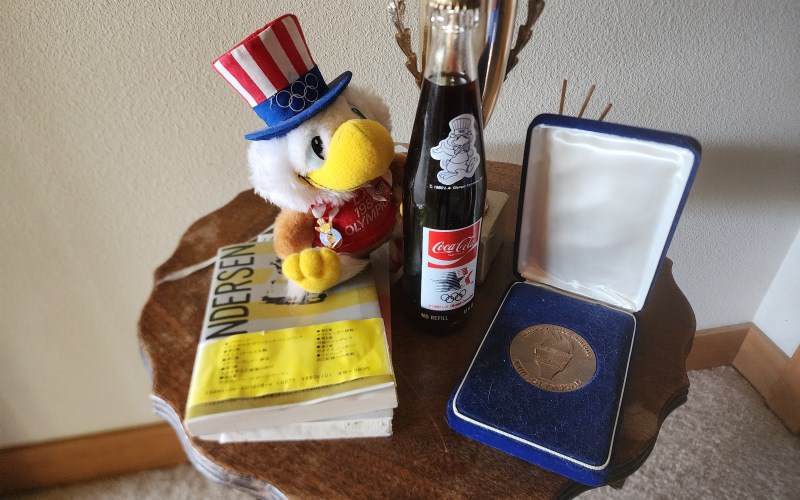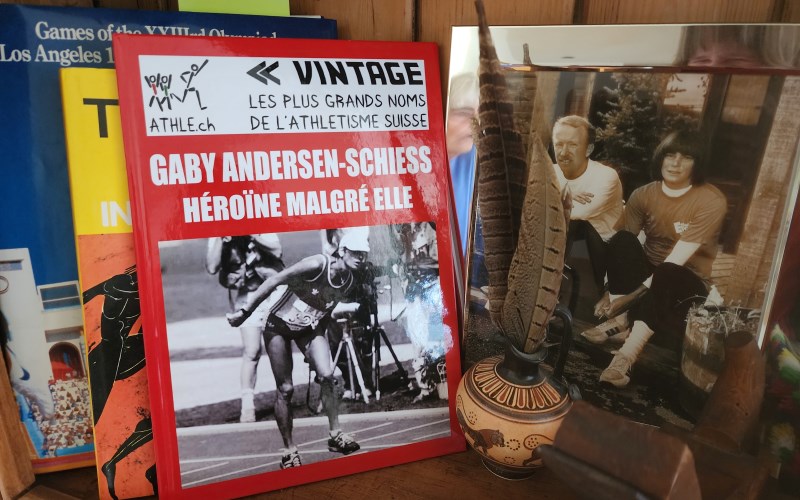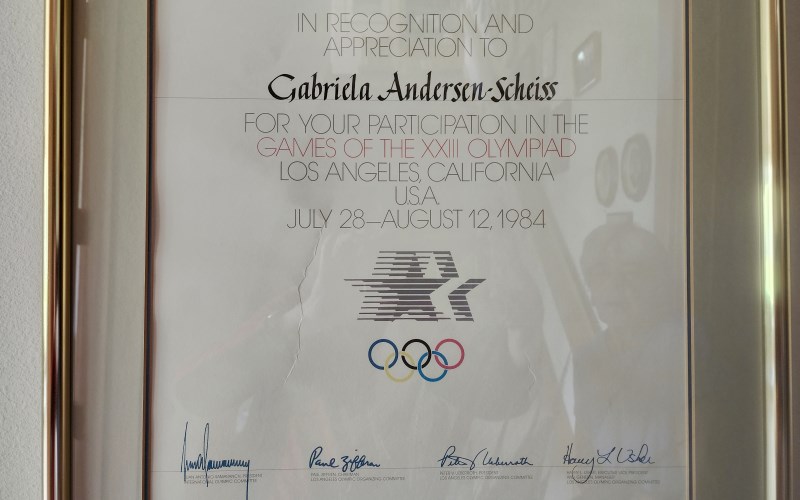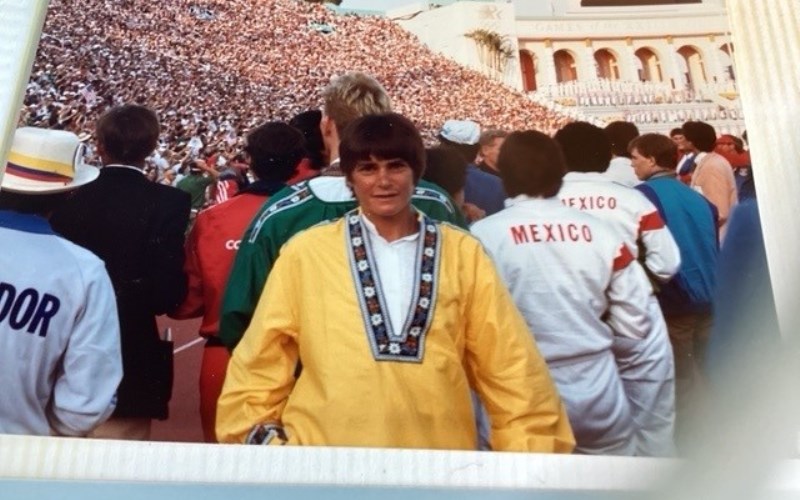|
STORY AND PHOTOS BY KAREN BOSSICK Chances are you can’t remember who won the first women’s marathon at the 1984 Summer Olympics in Los Angeles. But if you saw it, you likely never forgot watching a Swiss runner stagger from side to side, refusing to give up, as she ran the last lap around the stadium on a scorching afternoon. That woman, though born in Switzerland, had called Sun Valley home for years, training for her Olympic debut with local runners. And on Wednesday Gabriele Andersen-Schiess will be on hand to discuss that iconic moment in Olympic history when author Doug Levy presents his new book “Hero Redefined: Profiles of Olympic Athletes under the Radar” at Ketchum’s Community Library.
|
|

A stand contains Olympic memorabilia, including a biography written in Japanese.
|
|
|
The free presentation begins at 5:30 p.m. Wednesday, July 30. You can reserve a seat to see it in person at https://thecommunitylibrary.libcal.com/event/14518919. Or, watch it online at https://vimeo.com/event/5130452. The presentation will also be recorded and available to watch later on the library archive. Andersen-Schiess has never tried to capitalize on her 15 minutes of fame following the 1984 Summer Olympics, preferring to remain under the radar. But Levy couldn’t forget her determination. “I had a vivid memory of 1984 Olympic Games, watching this woman half walking, half crawling, struggling to get to the finish line. I thought, ‘How outstanding!’ She had nothing to gain other than personal pride. But, somehow, she persevered and finished.” Just getting to run in a marathon was a feat of sorts for Andersen-Schiess, who grew up during a time when people thought women were too fragile to run long distances.
|
|

Dick Andersen took this picture of his wife at the 1984 Summer Olympics in Los Angeles.
|
|
|
Born in Thun, a picturesque village at the base of the Bernese Alps, she attended a demanding Swiss school from 8 a.m. to 4:30 p.m. in winter and 7 a.m. to 4 p.m. in summer with an hour break for lunch and just six weeks of summer vacation. While she skied and hiked, there were no afterschool sports. She didn’t get into organized sports until she attended the University of Zurich where she earned a degree in history and art history. It was while she was pursuing a graduate degree in physical education at the same institution that Albert Einstein studied that she began running with friends, some of whom were members of a track club. “I didn’t start running until I was 25. That’s one reason I stuck with long-distance running. It was fun being with other women, doing training runs together. We didn’t have all this science, the equipment they have for runners to train on now. We just ran.” When Andersen-Schiess started running, the longest race women were allowed to run was 1,500 meters. As soon was running 3,000 meters was allowed, she was on top of it, winning Switzerland’s national title in 1972.
|
|

Gabriele Andersen-Schiess’ unforgettable run was captured in press from around the world.
|
|
|
A year later, a coach told her about the Black Forest Marathon. She went, she enjoyed it and she did “pretty well,” finishing it in just over three hours--an amazing feat considering the first woman to run the Boston Marathon in 1967 did so in four hours 20 minutes. That same year, Andersen-Schiess moved to the United States where long-distance running was gaining popularity. She met Dick Andersen while he was a student at Northern Arizona University in Flagstaff, Ariz. They married in 1975 and moved to Sun Valley where Andersen handled Sun Valley Resort’s beverage department and Andersen-Schiess taught skiing, took care of the hotel flowers and worked concierge. The 5-foot-2 athlete won a Great American Ski Chase Series in 1980 as a member of a Nordic ski team and finished runner-up in NBC Sports Survival of the Fittest in 1982. And she won that year’s Pikes Peak Marathon in 2 hours, 44 minutes.
|
|

The Olympic certificate misspelled both her first name and her last.
|
|
|
“In 1983 I ran the Great Potato Marathon in Boise in 1:42 and my friends said, ‘You just qualified to run in the Olympic marathon for the United States. I ran a couple more marathons and got better and figured I had a better chance to make the Swiss team since I had kept my Swiss citizenship, in addition to getting an American citizenship.” The next several months Andersen-Schiess ran from her home in Warm Springs out past the Board Ranch and the hot springs, sometimes with moose or bears watching her from a distance. “There weren’t that many trails here then. I wish we had had then what we have now,” she said. “I also trained at Adams Gulch—there was nobody there then. And two times a week I’d go to Hailey and run around the track at the high school.” Leading up to the Olympics, Andersen-Schiess won the Twin Cities Marathon in 2:36, finished second in San Francico and set a Swiss record of 2:33 at the California International Marathon. She got a deal with Adidas and finished sixth in the Boston Marathon with a time of 2:39.
Her goal was to finish among the first half of the women marathoners in 1984, even though she was 39 years old--one of the oldest Olympians in Los Angeles. Determined to enjoy as much as she could, she stood in the opening ceremonies in the hot sun for four hours. Then she flew back to Sun Valley to train at altitude while she awaited the marathon. “In hindsight I probably should have stayed in Los Angeles and acclimatized. But I didn’t have a hands-on coach so I didn’t think about that.” Andersen-Schiess was only seven minutes off the pace of Maine’s Joan Benoit, who would go on to win the marathon, at the 18.64-mile mark. She was in eighth place at mile 20.
But the temperature ramped up to 90 degrees with 95 percent humidity as she left the shaded streets for the Los Angeles freeway where heat radiated off the pavement. Things began falling apart for her at mile 24. “I could tell I was getting dehydrated,” she recounted. “Then, they only had water stations every five miles—after my experience, they started putting them every mile. I remember going through the tunnel into the stadium and it was so nice and cool. But my legs were so cramped up, so painful, I could barely move them. And I felt like I was burning up. All I could do was think: I have to follow the white line one and a half times around.” The crowd quieted as they saw Andersen-Schiess enter the stadium staggering, unable to control her legs. Then they roared as they saw she was determined to finish. She waved off the doctors and the crowd rose to their feet cheering for the five minutes and 44 seconds it took her to complete a final lap that takes most elite runners just over a minute.
One columnist later dubbed it “The Most Incredible Final Lap in Olympic Marathon History,” Levy wrote. And, while she finished 24 minutes behind Benoit, she finished in 2:48:44—faster than the men’s gold medal winner in first five Olympic marathons and ahead of seven fellow competitors. Doctors plied her with fluid and ice to get her body temperature down and three hours later she felt okay. Then the media came calling. “I had to go to a late-night news show everybody I didn’t die,” she said. “The next morning there was a press conference and I was embarrassed. Why were they interviewing me and not the winner? I was surprised—I had made every newspaper around the world.” Some in her home country said she should have quit. But she was hailed as a hero in the United States, in South America and even as far away as Japan.
And then she came home to her cherished life in Sun Valley where she could continue to push herself hard—just out of the spotlight. Today Andersen-Schiess lives in an attractive home her husband built in Elkhorn in 1990. And, though 80, she still hasn’t learned how to quit. When she had a knee replacement in 2018, she skied right alongside Paralympic contenders that adaptive ski instructor Marc Mast was training in a sit ski. In November she broke her pelvis and sustained a concussion when a motorist hit her while she was biking in Palm Desert. But she was back on her skis and snowboard by February. And come summer she resumed mountain biking--until a fall at the Quigley Bike Park sidelined her again. “I was biking on the ramp there and missed the turn and fell off and broke my pelvis and my collarbone. But I’m on week six so I should be able to hike soon. Dick says he’s going to take my bike away; I think I will stay away from the bike park.”
Andersen-Schiess noted that she should be spending more time rehabbing at the gym. “But I don’t like it. Living here is paradise and I want to be outside. It rained a lot in Switzerland. It was grey there with inversions. And the snow was wet, not like the snow on Bald Mountain. Being out in nature here fills me.” A small table at the bottom of a long set of stairs holds Andersen-Schiess’ Olympic memorabilia, including a medal given those who competed, a souvenir Coca Cola bottle, an Uncle Sam mascot and a certificate that misspelled her name Gabriela Andersen-Scheiss. There’s even a copy of a biography a Japanese journalist wrote about her.
“I’ve never read it as I don’t know Japanese,” she said. Andersen-Schiess said she would love to get a do-over to train for running long distances, given the science, gym equipment and shoes they have now. But she knows better than anyone the most important thing is what’s inside. “When you have a setback, you overcome it and you don’t get intimidated or give up,” she said.
|